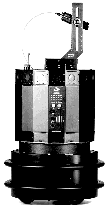Behavior-Based Robotics
Introduction
 A Nomad robot used by many researchers to study behavior within a laboratory setting.
A Nomad robot used by many researchers to study behavior within a laboratory setting. As a design strategy, the behavior-based approach has produced intelligent systems for use in a wide variety of areas, including military applications, mining, space exploration, agriculture, factory automation, service industries, waste management, health care, disaster intervention and the home. To understand what behavior-based robotics is, it may be helpful to explain what it is not. The behavior-based approach does not necessarily seek to produce cognition or a human-like thinking process. While these aims are admirable, they can be misleading. Blaise Pascal once pointed out the dangers inherent when any system tries to model itself. It is natural for humans to model their own intelligence. The problem is that we are not aware of the myriad internal processes that actually produce our intelligence, but rather experience the emergent phenomenon of "thought." In the mid-eighties, Rodney Brooks (1986) recognized this fundamental problem and responded with one of the first well-formulated methodologies of the behavior-based approach. His underlying assertion was that cognition is a chimera contrived by an observer who is necessarily biased by his/her own perspective on the environment. (Brooks 1991) As an entirely subjective fabrication of the observer, cognition cannot be measured or modeled scientifically. Even researchers who did not believe the phenomenon of cognition to be entirely illusory, admitted that AI had failed to produce it. Although many hope for a future when intelligent systems will be able to model human-like behavior accurately, they insist that this high-level behavior must be allowed to emerge from layers of control built from the bottom up. While some skeptics argue that a strict behavioral approach could never scale up to human modes of intelligence, others argued that the bottom-up behavioral approach is the very principle underlying all biological intelligence. (Brooks 1990)
 Junior: An all-terrain robot recently used to deploy a gamma locating device within a radioactive environment.
Junior: An all-terrain robot recently used to deploy a gamma locating device within a radioactive environment. To many, this theoretical question simply was not the issue. Instead of focusing on designing systems that could think intelligently, the emphasis had changed to creating agents that could act intelligently. From an engineering point of view, this change rejuvenated robotic design, producing physical robots that could accomplish real-world tasks without being told exactly how to do them. From a scientific point of view, researchers could now avoid high-level, armchair discussions about intelligence. Instead, intelligence could be assessed more objectively as a measurement of rational behavior on some task. Since successful completion of a task was now the goal, researchers no longer focused on designing elaborate processing systems and instead tried to make the coupling between perception and action as direct as possible. This aim remains the distinguishing characteristic of behavior-based robotics.
The sub-sections which follow explain the roots of behavior based robotics, how it rose as a counter to the symbolic, deliberative approach of classical AI and how it has come to be a standard approach for developing autonomous robots.
A special thanks to Ronald Arkin whose book, Behavior Based Robotics, has greatly influenced this report.